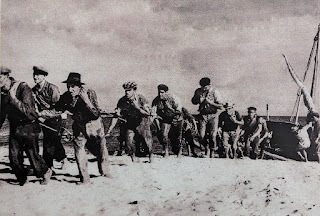From the riverside dock in Tavira we took the ferry south to Ilha de Tavira (Tavira Island). The island caters to visitors looking for a day on the Atlantic, complete with umbrellas, lounge chairs and drinks. However, walking along the beach another 3 km to the west we found ourselves at the Cemiterio das Ancoras or the Anchor Graveyard. This site above the beach at Barril is a memorial to a lost way of life, tuna fishing, an industry that once thrived along the Algarve. These anchors were once used to secure the nets used to funnel tuna into a net pen where the fish would be lifted to the surface and loaded onto boats.
The Atlantic bluefin tuna return to the Mediterranean each spring (May and June) to spawn, and the migratory path has traditionally passed by the Portugese Algave. The ancient method of fishing for tuna using the almadravas (armacoes) or nets dates back to the time of the Phoenecians, and was used here until the early 1960’s, when the number of Tuna had declined.
Beyond the graveyard of anchors are several old buildings, once fisherman dwellings and storehouses, which are now tourist shops and cafes. One building, the Museu do Atun Restaurante, is a restaurant/museum which contains many period artifacts and photographs from the net fishing era. Also on display is an interesting diorama illustrating the set nets, anchors and cork buoys with the fishing boats surrounding the central copo or pen.
Diorama and Photographs from the Museum
Changes in the migratory patterns and dwindling numbers have ended the almadravas tuna fishing along the Portugese Algarve. But in Spain, this method is still being used along the coast near Cadiz by the Gadira Company, purveyors of Almadraba Wild Bluefin Tuna (https://www.gadira.com/).
Film clip of present day use of the Amadraba off Cadiz Spain:
https://www.youtube.com/watch?v=f3zhmXD8t6I
The following period documentary offers a great historical insight into the past era of net fishing along the Algarve. The number of people, upwards of 200, involved in preparing for the seasonal hunt was quite impressive. The film culminates in the somewhat savage scenes of raising the net and hoisting the hooked tuna onboard:
https://www.youtube.com/watch?v=U6AWwLbkz8w&t=236s













Comments
Post a Comment